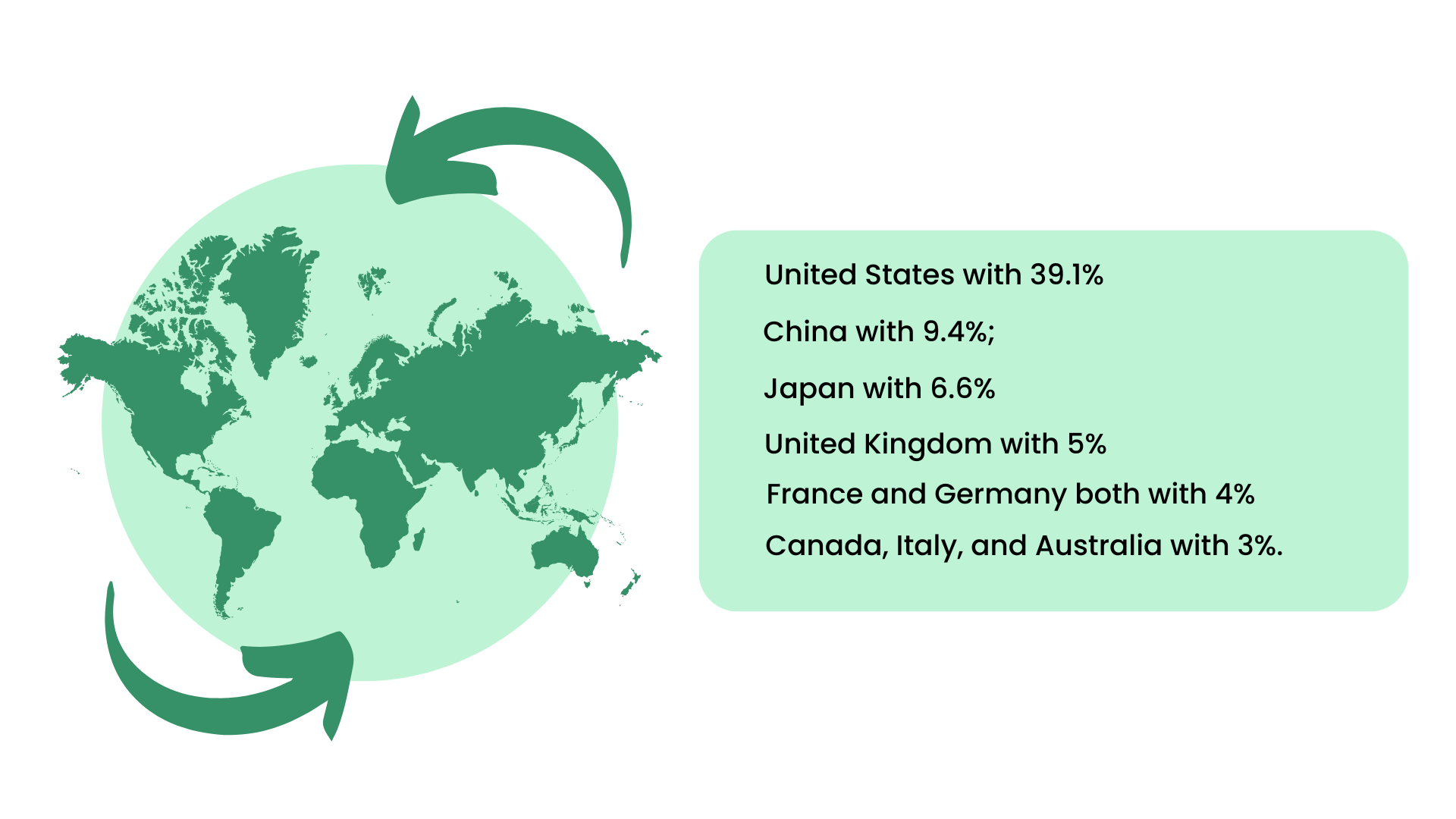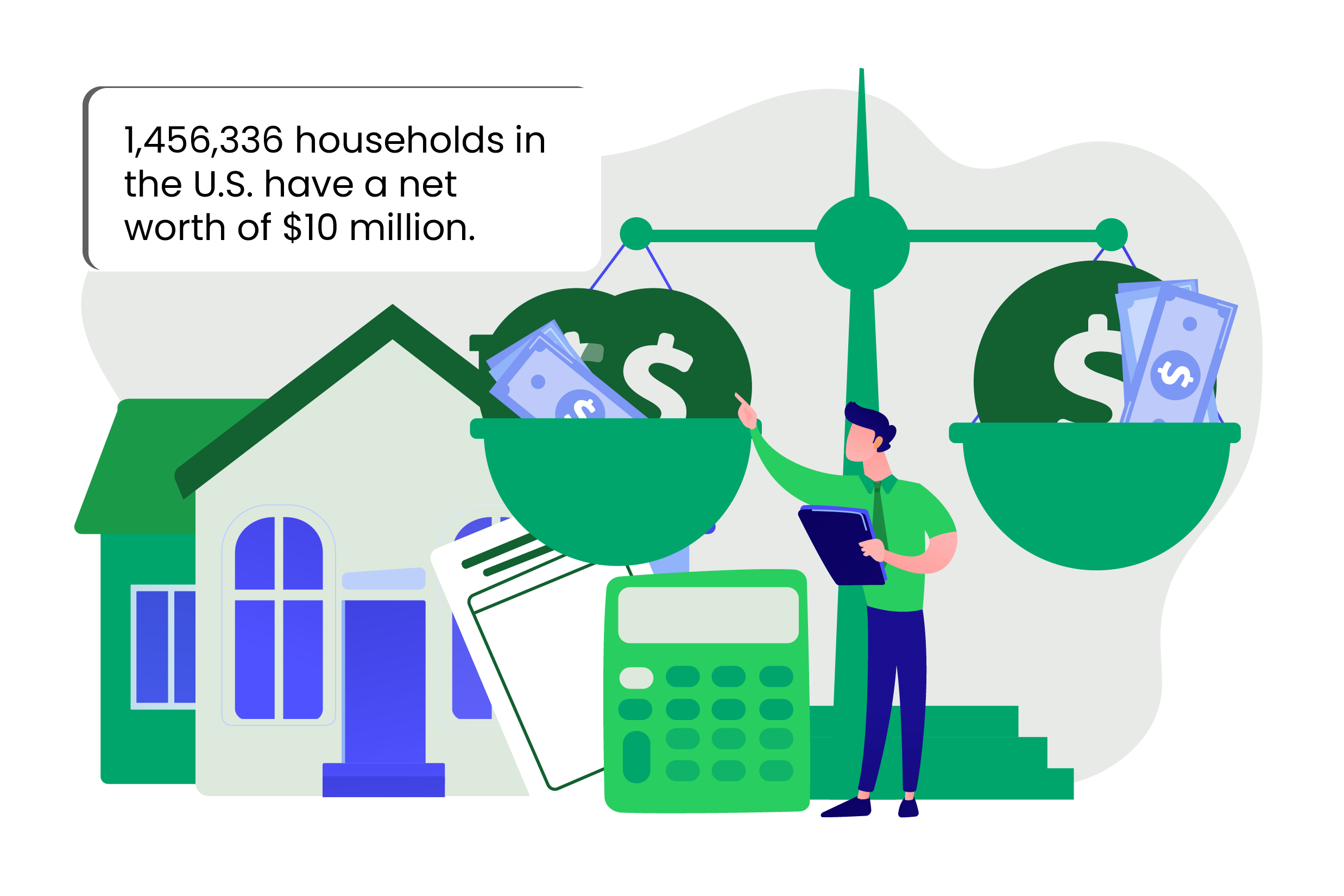What Does It Take to Become a Millionaire? 2023 Key Statistics

Despite the COVID-19 pandemic, an energy shortage and war between Russia and Ukraine, high-net-worth individuals continue to thrive in today's economy. In fact, during this period, there has been a steady increase in the number of millionaires and equal growth in the amount of wealth accumulated by already existing millionaires.
We have compiled a list of the most relevant and interesting millionaire statistics, categorized into the chapters below:
Key Takeaways
- There are 21.9 million millionaires in the U.S. or 8.8% of the population.
- There are 56.1 million millionaires worldwide.
- The chances of any individual becoming a millionaire hover around 22.4%.
- The member countries of G7 hold about 75% of the global wealth.
- 88% of millionaires created their wealth by their own means.
- College-educated, middle-aged Asians are the demographic most likely to become millionaires in the U.S.
- Experts claim that only 5% of people can become millionaires by doing nothing in particular.
- From 2016 to 2020, roughly 1,700 people became millionaires each day.
Global Millionaire Statistics
High-net-worth individuals live and work in many different parts of the world. It is, however, not surprising that the majority of the world’s millionaires live, work or do business in the United States.
Statistics from 2020 show that by the end of the year, there were 56.1 million millionaires around the world
This would translate to 1.1% of the global population. This number shows an increase from the previous years, as the pandemic helped many join the millionaire ranks.
There are 21.9 million millionaires in the United States alone
The U.S. continues to have not only the highest number of millionaires but is also home to the most billionaires, with 724.
Elon Musk is the richest person in the world with a net worth of $235.8 billion
While the number one spot for the richest person on the planet keeps changing every now and then, for 2022 the spot goes to the Tesla mogul.
More than half of all the world's billionaires are between the ages of 50 and 70
The current number of billionaires hovers around 2,755. Accumulating such large amounts of wealth is no easy task and it certainly requires a lot of time and effort, so it stands to reason why the majority of the 1% falls into this age group.
88% of millionaires accumulated their wealth on their own through independent ventures
Statistics show that only a small percentage of those in this category earned their millionaire status by inheritance or help from their families. Furthermore, roughly 70% of millionaires never earned a six-figure annual salary during their careers.
The U.S. and China lead with the highest percentage of millionaires
According to 2021 data, the percentage breakdown of millionaires around the world is as follows:

Switzerland has the most millionaires per capita
While the U.S. might have the highest total number of millionaires, Switzerland has the highest number of millionaires in proportion to the number of citizens: 14.9% of Switzerland’s population own more than $1 million in assets. Australia comes in second with 9.4% and, in third place, the U.S. and Luxembourg tie in with 8.8%.
4,000 high-net-worth individuals are projected to move to the United Arab Emirates by the end of 2022
The UAE continues to attract millionaires due to the many policies in place that best accommodate them and their wealth.
Ukraine, Russia, and China are projected to lose the most millionaires by the end of 2022
Ukraine is set to lose the biggest largest number of high-net-worth individuals, roughly 42% of them are expected to leave the country by the end of the year. Russia is also set to lose around 15,000 millionaires during the same period. China could see a loss of around 10,000 millionaires.
The top 1% of the wealthiest across the globe currently hold $191.6 trillion of the world’s wealth
That means that 56 million people have accumulated roughly 46% of global wealth.
U.S. Millionaire Statistics
The U.S. is home to most millionaires in the world; not only that, it is also home to 724 billionaires in total. Here are some of the most interesting facts about millionaires in the U.S.:
America is home to 21.9 million millionaires
While this is a significant increase from previous years, projections say that this number will increase by 28% by 2025.
The first millionaire in the U.S. was John Jacob Astor, a fur trader and real estate investor
He accumulated his wealth by focusing on trade. Astor's net worth at the time reached $20 million, which adjusted for inflation would be equal to $100 million today.
Among U.S. millionaires, only 33% of them are women
It’s no surprise that women in America earn less than their male counterparts, and the wealthiest are no exception.
39.1% of the world’s millionaires are from the U.S.
In 2020 alone, the U.S. got 1.7 million new millionaires. The cause of this phenomenon is presumably the pandemic, stock market gains and the booming housing industry.
New Jersey is the state with the most millionaire households across the U.S.
The other five states with the most millionaires per capita are: New Jersey: 9.76%; Maryland: 9.72%; Connecticut: 9.44%; Massachusetts: 9.38%; Hawaii: 9.2%.
According to statistics, 8 out of 10 millionaires got their wealth from investing in company 401(k) plans
Many companies provide 401(k) plans for their employees; however, only about 40% invest in them, according the U.S. Census Bureau.
The average America has a net worth of about $79,952
By comparison, a millionaire in the U.S. has accumulated roughly 821% of that wealth. While the total American wealth keeps increasing, the number of individuals who control said wealth stays about the same, and relatively low.
Wealth in America increased by 13.8% in 2021
Global wealth increased in general, but North America continued leading in wealth accumulation. This is mostly attributed to growth in the tech sector and pandemic-related developments.
32% of millionaires in North America have their entire wealth invested in the stock market
In comparison, the global number is only 29%. The stock market has played a crucial role in wealth accumulation over the last few years, with a lot of individual investors making significant gains.
By April 2022, the global wealth among millionaires had decreased by 4% compared to 2021
This decline is especially prevalent in the U.S.; however, it has also been experienced in Europe as well due to geopolitical developments.

1,456,336 households in the U.S. have a net worth of $10 million
Meanwhile, 8,046,080 households have a net worth of $2 million and 5,671,005 households have a net worth of $3 million.
The Federal Reserve reports that the top 10% in the U.S. are in possession of 69.6% of the nation’s total wealth
To put it into perspective, the bottom 50% of Americans own only 2% of the wealth in America.
43% of all U.S. millionaires own just one house
Real estate is one of the best investments to make and one of the more common ones found among millionaires. 20% of millionaires own two houses, and just 8.5% of them own five or more houses.
Among members of Congress, 229 are millionaires
Determining the specific number of millionaires in Congress is a difficult task due to the way their finances are reported. According to the Center for Responsive Politics, in 2018 43% of them had a net worth of $1 million or more.
Reports show that 85% of U.S. citizens think billionaires should pay a wealth tax
With an increase in efforts for wealth equity and fair wealth distribution, the sentiment of the general public seems to be that the richest of the population pay more taxes.
Millionaire Statistics by Demographic
Wealth is understandably not spread out evenly among all demographics. Certain groups tend to be predisposed to gaining wealth more than others. Here’s a breakdown:

The demographic most likely to become millionaires in America are middle-aged, college-educated Asians
Projections show that over 22% of Asians that have a bachelor’s degree will become millionaires, a significant percentage considering that the Asian demographic in the U.S. accounts for just 6% of the population.
White, middle-aged, college-educated Americans are the next category most likely to become millionaires
About 21.5% of people in this category are likely to become millionaires; this is a significant number considering that roughly 60% of the American population is white.
6.8% of middle-age, college-educated Hispanic or Latino individuals in the U.S. are likely to become millionaires
The Hispanic and Latino population currently makes up 19% of the total U.S. population.
Roughly 6.4% of middle-aged, college-educated Black Americans will become millionaires
Black Americans make up just about 13% of all the U.S. population.
The average age of millionaires is 57
However, the age where most millionaires made their very first million is 37.
Most people's chances of ever becoming a millionaire peak at 61
In order to become a millionaire, most people carefully manage their finances over a long period. While the odds of people of color earning millionaire status after 61 get progressively lower, the opposite is true for white people.
Out of all American households with a net worth of $1 million, only 2% of them are Black
The disparity in wealth between the races in the United States is nothing new; this disparity extends to the wealthiest categories as well.
According to Fidelity, of all 401(k) account holders who possess at least $1 million, 20% are women
The gender pay gap continues to affect women of all ages but it hits women in the older age brackets particularly hard. Retirement funds are just one of the facets that give a glimpse of the difference in earnings between men and women.
The number of millennial millionaires in the U.S. is 618,000
Roughly 93% of them have net worths ranging from $1 to $2.49 million. While the majority of millionaires fall into older age brackets, the number of millionaire millennials is expected to rise.
Millionaires by Industry and Profession
While millionaires come from different professions, there are some industries that statistically generate the most millionaires around the world.
The top five industries that have generated the most millionaires around the world are:
Investments and finance, technology, manufacturing, health care, real estate and construction.

Most millionaires are college-educated
Around 84% of millionaires have graduated from college, and 1 in 3 millionaires funded their own education. It’s safe to say that academic success increases the chances of one becoming a millionaire.
Only 15% of positions held by millionaires in their companies are at a senior level
In every respective industry, a very small percentage of millionaires have actually held positions like CEO or CFO.
71% of millionaires have invested in digital assets
91% of high-net-worth individuals who invest in digital assets are younger than 40. Cryptocurrencies seem to be the preferred digital investment for millionaires worldwide.
Predictions show that by 2025 the global number of millionaires will reach 84 million
This would account for an increase of almost 50% from the current number of global millionaires. The number of those with more than $30 million is also expected to increase by 60% as well.
